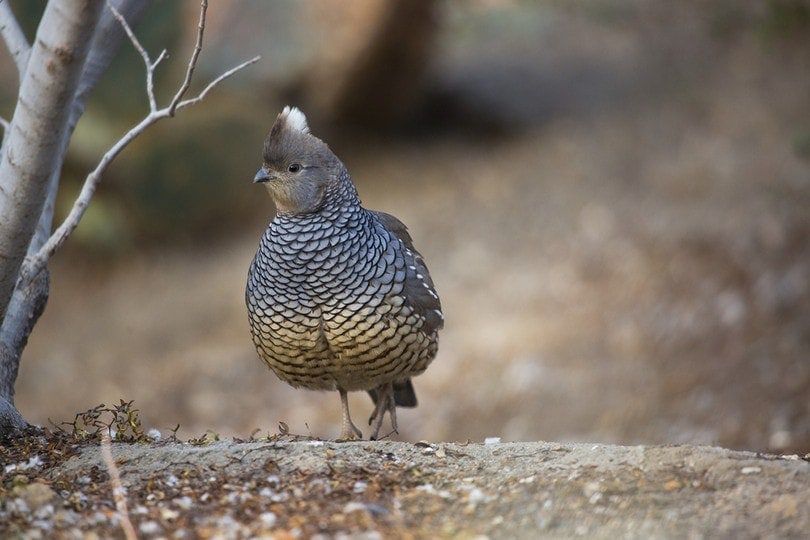Small birds are common and popular additions to many homesteads and even backyard aviaries. Quails are especially popular for their dainty sizes, delicious eggs, and quiet natures – no loud chicken crow in the earliest hours!
Also going by the names Blue Quail, Scaled Quail, and Cottontop Quail, the Blue-Scaled Quail makes an adorable addition to many aviaries. They are widespread and accessible to source, making them an excellent choice for many aviculture hobbyists. However, they have some characteristics that all potential owners should understand to provide them with the best care.

Quick Facts about Blue-Scale Quail
| Breed Name: | Blue-Scale Quail |
| Place of Origin: | Southwestern United States |
| Uses: | Egg production, pets, hobby |
| Cock (Male) Size: | 6 – 8 ounces (175 – 190g) |
| Hen (Female) Size: | 6 – 8 ounces (175 – 190g) |
| Color: | Grey, brown, blue, white |
| Lifespan: | 1.5 years in the wild, 5 – 7 in captivity |
| Climate Tolerance: | Good for most climates |
| Care Level: | Medium |
| Egg Size: | Small: 1-inch width, 8 – 13g weight |
| Egg Color: | White with irregular brown spots |
| Egg Productivity: | Moderate: 50 – 60 eggs per year |

Blue-Scale Quail Origins
The Blue-Scale Quail is a species of the New World Quail family. They are widespread through the southwest of the United States and commonly found in Arizona, Colorado, Kansas, Texas, New Mexico, and Oklahoma. They are also seen as natives in Mexico.
They have long been found in domestic settings in addition to their wild populations. The exact origin has not been recorded, but they have been a food source for centuries considering their long-established history. Nowadays, they are hunted for sport and raised for eggs and meat in captive settings.
Blue-Scale Quail Characteristics
Blue-Scaled Quails possess the classic quail trait of being rather skittish. They survive in the wild by utilizing natural cover and being extraordinarily wary. To avoid falling prey to any animal larger than them, they remain on constant alert and react to threats quickly. Even in captive domestic settings, owners report that this quail species rarely loses this nervous native even having been in a secure environment since their hatching.
Despite being excellent fliers, Blue-Scaled Quail often run rather than fly away. They can run up to 15 miles an hour and quickly evade and hide from threats. When kept in large groups of birds (up to 30 individuals), they roost close to each other to stay warm. They will also assemble themselves in a circle while roosting to collectively keep an eye out for approaching predators.
While they are more used to the warmer climate of the south, they are remarkably tolerant to many temperatures if kept in these large groups. If keeping them outside of their natural southwest range, they will need to be kept sheltered in a barn or in a large convey. They are very social and should be kept in pairs at the very minimum.

Uses
Blue-Scaled Quails are often kept for purely hobby and pet purposes. These little cuties are loved by aviculturists who keep many species. They are agreeable and get along fine with many other species.
They also are raised for both eggs and meat. Each female will lay 50-60 eggs in a year, so keeping a flock can provide you with a decent supply of quail eggs. These eggs are often considered a delicacy and are more nutritious than regular chicken, having more protein, iron, and vitamin B12 per gram. They are also relatively inexpensive to purchase, so they are efficient to raise for meat purposes, despite having little meat.
Appearance & Varieties
Blue-Scaled Quail only have one variation for the species. They are blueish/grey in color, with the breast mottled with white. This mottling extends from the neck, down the breast, to the underbelly and is the source of their name as it resembles scales.
They are also clearly identifiable from their white crest of feathers that adorns their heads. Unlike some species of quail, there is no apparent sexual dimorphism, meaning there are no distinguishing physical differences between the male and the female. Upon very close inspection, the throats have slightly different tones, with the females looking more light yellow while the males are ash grey. In addition, the males are only marginally larger in average weight.

Population, Distribution & Habitat
Blue-Scaled Quail are easily found naturally and are considered “Of Least Concern” by the IUCN. However, their population is on a decreasing trend, likely due to human influences on their habitat.
Their natural habitat tends to be desert, scrub, and grassland areas. They utilize the natural cover of low, dense scrub for camouflage. They thrive in undisturbed areas, particularly spaces such as refuges and national parks. However, they are also common in crop fields and pastures.

Are Blue-Scale Quail Good for Small-Scale Farming?
Like many common quail species, the Blue-Scaled Quail is a good addition to many homesteads to be a source of meat and eggs. This product can be efficiently raised for personal use but also selling. While the price of birds and eggs is relatively cheap in poultry circles, eggs and meat may sell for more in market and urban settings.
Keeping these quail requires a suitable habitat that offers protection from the elements and predators in the natural cover of grass and shrubs. They will do best in environments that closely resemble their natural range and may require more care in unnatural environments. They can also crossbreed with other quails such as Bobwhites and Gambels, so they must be kept separate during the breeding season.
These quail can be easily raised for small-scale farming or simply for fun with the proper care!
See also:
Featured Image Credit: Dirk M. de Boer, Shutterstock
